The Professional Slingshot: Boosting Kiteboarding Skills
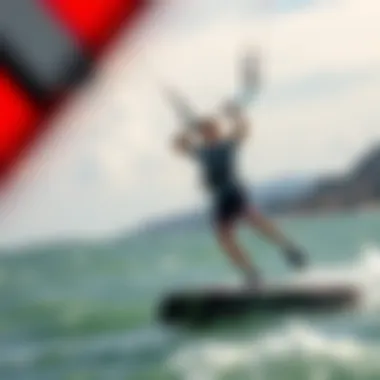
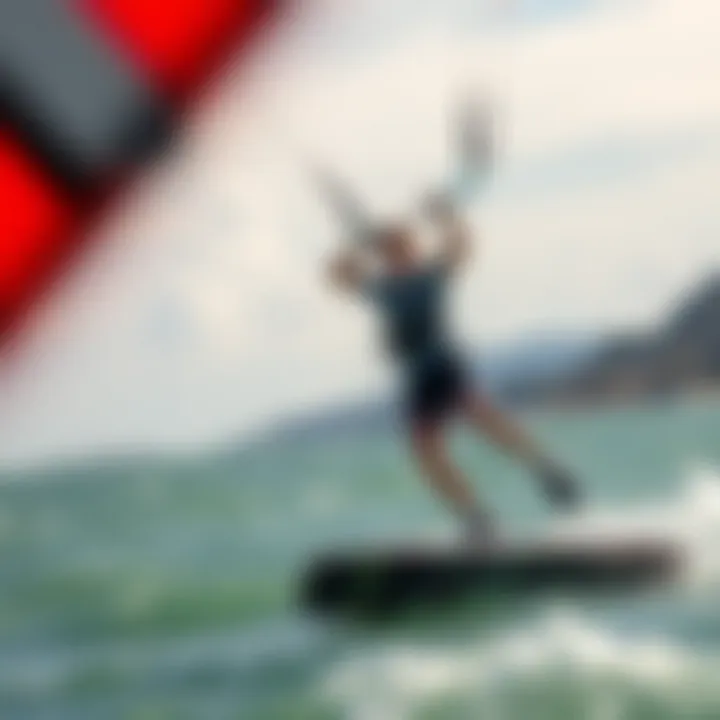
Intro
Kiteboarding has taken the world by storm, marrying the thrill of surfing with the rush of flying. Among the many techniques riders can employ, the professional slingshot maneuver stands out. This technique not only elevates performance but can also transform the kiting experience from ordinary to extraordinary. Mastering the slingshot can help riders navigate challenging winds and gather speed quickly.
This article dives into the essence of the slingshot, exploring its mechanics, how it impacts performance, and the gear necessary for executing it effectively. Whether you are a rookie looking to gain confidence or an experienced kiteboarder aiming to hone your skills, there's something here for everyone.
Let's unpack the essentials of the slingshot technique and the key elements that can help enhance your kiteboarding performance.
Understanding the Professional Slingshot in Kiteboarding
The professional slingshot technique is a cornerstone of high-performance kiteboarding. Understanding this maneuver is crucial for anyone looking to elevate their skills on the water. It’s not just about aesthetics; the slingshot can significantly enhance speed, control, and overall maneuverability. Kiteboarders who grasp this technique often find themselves standing out, whether in competitions or casual outings.
Defining the Slingshot Technique
The slingshot technique involves a sudden change of direction that allows a kiteboarder to catch a burst of speed using the kite’s power. Essentially, the kite is positioned to maximize pull while the rider leans back, preparing for an explosive acceleration. Despite its simplicity, mastering this technique requires practice and understanding, integrating timing, kite position, and rider stance.
For instance, when properly executed, the slingshot allows the rider to transition seamlessly from a downwind direction to an explosive upwind stance, making the most of the wind's lift. Think of it as a rubber band; when stretched and let go, it can propel forward with great force. This is the core idea behind the slingshot maneuver.
The Role of Kite Dynamics
Kite dynamics play a critical role in slingshot execution. The angle at which the kite is pulled, the tension in the lines, and even the wind conditions can dramatically impact performance. When the kite is set at the right angle, it can generate more lift and speed. Understanding how to manipulate a kite’s power zone—where it catches the most wind—can mean the difference between a slick maneuver and a tough tumble.
Additionally, knowing how to adjust your kite’s position based on its aspect ratio and intended use can influence execution. A kite with a higher aspect ratio typically flies faster and stays stable in the air, making it conducive for slingshots. Conversely, a lower aspect ratio kite offers more immediate power at lower speeds but can be tricky to control in a dynamical slingshot situation.
Impact on Performance and Maneuverability
The slingshot technique has a profound effect on both performance and maneuverability. By allowing kiteboarders to tap into the kite’s full potential, it creates opportunities for sharper turns, greater speed, and impressive aerial tricks. The ability to launch off the water with power and precision depends largely on executing a clean slingshot.
Consider this: when you master the slingshot, you gain the ability to link tricks together more fluidly. Whether it’s jumping, spinning, or even barrel rolls, a solid approach to slingshot maneuvers allows for a more graceful transition between moves. In the competitive scene, this fluidity can translate to higher scores and greater recognition.
In summary, understanding the professional slingshot is not merely an addition to a kiteboarder's skill set but a necessary evolution in practical performance. By embracing the intricacies of this technique, riders can enhance their overall experience in kiteboarding, pushing themselves to new limits.
Equipment Essentials for Slingshot Execution
Choosing the right equipment is essential for executing the slingshot technique effectively. As any seasoned kiteboarder can tell you, having the right gear influences not only your performance but also your safety on the water. When it comes to slingshot maneuvers, the kite, board, and harness all play significant roles. It’s not just about personal preference; the synergy between these components can make or break your ride.
Choosing the Right Kite
Selecting the right kite is like picking the right tool for a job. It’s vital to consider the size and type that matches your skill level and the conditions you intend to ride in. A kite designed for slingshot maneuvers should offer quick responsiveness and ample power.
- Size Matters: Smaller kites are often more maneuverable, making them ideal for slingshots. On the other hand, if conditions turn gusty, a slightly larger kite might give you more lift but could also make control a bit trickier.
- Type of Kite: You can generally choose between C-kites and hybrid kites for slingshot techniques. C-kites provide direct response and are favored for their precision in tricks, whereas hybrid kites offer versatility for varied conditions.
In any case, it's essential to try out different kites before committing. High-performance kites, like the North Orbit or Naish Pivot, are often recommended for their reliability and ease of handling.
Selecting the Appropriate Board
Your board is your other half when it comes to kiteboarding. A board tailored for slingshot use will have characteristics that enhance your performance through quick turns and better upwind ability.
- Board Shape: A smaller, directional board can be a terrific option, giving you the ability to perform rapid maneuvers. Various shapes designed for different styles exist, so understanding how your board interacts with the kite is crucial.
- Flex and Stiffness: Kickboards that have a stiffer flex tend to perform better in slingshot scenarios as they help you maintain speed and control.
Don’t shy away from asking fellow kiteboarders about the boards they prefer. Experimentation often leads you to discover what feels right under your feet.
Harness Considerations
A well-fitting harness can enhance your performance significantly while executing slingshot maneuvers. It’s more than just supporting your body; it helps in transferring control between yourself and the kite.
- Type of Harness: You can choose between seat harnesses and waist harnesses. Waist harnesses offer more mobility and are often the preferred choice for slingshot maneuvers, allowing more fluid movement. However, seat harnesses can provide extra support, reducing pressure on the lower back during intense rides.
- Fit and Comfort: The harness needs to fit snugly without causing discomfort. If it feels too loose or tight, your performance can easily suffer, particularly when you are trying to pull off high-speed maneuvers.
In the end, many kiteboarders find that their preferred harness combines functionality with comfort— like the Mystic Majestic or ION Fuse. Both offer great support while allowing for the necessary freedom of movement.
"Every kiteboarder has their magic combo of kite, board, and harness. Spend the time to experiment, and you’ll find what works best for you."
Overall, when it comes to the slingshot technique, understanding how each piece of your gear interacts with one another isn’t just important; it’s essential. The right equipment not only prepares you for success but also enhances your overall kitesurfing experience.


Mastering the Slingshot Technique
Mastering the slingshot technique is crucial for any kiteboarder looking to elevate their performance on the water. This technique involves harnessing the potential energy of both the kite and the rider's movements to achieve a burst of speed, enabling a range of advanced maneuvers. Understanding the slingshot is not just about the execution; it's about feeling the rhythm of the wind and water, and knowing how to harness them harmoniously.
The benefits of mastering this technique are manifold. Enhanced speed translates to improved overall ride quality, allowing for better jumps and turns. Kiteboarders will find themselves capable of tackling more challenging conditions and executing tricks with finesse. Moreover, techniques like the slingshot foster a deeper connection between the rider and their environment, creating a more immersive kiteboarding experience.
Step-by-Step Guide to Execution
Positioning Your Body
The heart of a successful slingshot starts with proper body positioning. It’s about aligning your center of gravity with the kite's pull. Imagine standing on the edge of a diving board, ready to leap; that same focus and preparation is vital in kiteboarding. One key aspect of body positioning involves bending your knees slightly and shifting your weight towards the back of the board. This posture not only stabilizes the rider but also prepares the body to absorb the force of the slingshot.
Another characteristic is how your upper body should remain relaxed yet engaged, allowing for quick adjustments. Riders who master this aspect often find themselves more in tune with their kite. The unique feature of this position is that it creates a spring-like tension in the legs and hips, making it easier to execute the pull. Conversely, if a rider does not maintain a strong posture, they may struggle with balance and control upon exit, leading to a compromised experience.
Initiating the Pull
Initiating the pull is where excitement meets strategy. It involves the moment you decide to go from stationary to fast-paced. The technique typically requires a sharp tug on the control bar while simultaneously leaning back with purpose. This action does not merely increase speed; it transforms potential energy from the kite into kinetic energy.
The key here is timing. Too early, and you risk losing balance; too late, and the moment may pass you by. The beauty of this technique is in its seamless nature: it’s almost as if the kite’s pull guides your movements. An advantage of getting this step right is that a smooth, well-timed pull can lead to a sustained speed that feels almost effortless. On the downside, riders who initiate the pull too aggressively may face instability, leading to a less controlled ride.
Controlling Exit Speed
Once you've mastered the pull, attention turns to controlling exit speed. This is pivotal in how you transition out of the slingshot maneuver. The idea is to maintain a balance between speed and direction; after all, in kiteboarding, speed must always align with where you want to go.
To effectively control exit speed, riders need to remain aware of their body positioning and the kite's angle. By gently releasing grip on the control bar, you allow the kite to naturally carry you forward while remaining in control of your trajectory. The advantage of practicing this lies in its potential for smooth landings and transitions into tricks. However, if not executed thoughtfully, it may lead to abrupt stops that can result in loss of control.
Common Challenges and Solutions
Kiteboarding is not without its hurdles. Common challenges in mastering the slingshot include timing issues, improper equipment settings, and environmental factors. Riders might struggle with finding the right moment to initiate the pull or maintain balance throughout the maneuver.
One solution to improve timing is to practice with a partner who can offer feedback on your technique or record your sessions for review. Understanding your body’s movements through video can reveal areas of adjustment. In addition, adjusting the kite’s settings to match wind conditions can help mitigate issues with control stemming from equipment mismatch.
Practicing Safely
When it comes to kiteboarding, safety is of utmost importance. Always check the condition of your equipment and the environment before setting out. Investing in protective gear is essential, such as impact vests and helmets, which can save a rider from injury in case of a fall.
Creating a practice plan that includes warming up and cool-down stretches can optimize your sessions. A buddy system during practice ensures that someone is available to assist in emergencies. As the saying goes, better safe than sorry. By prioritizing safety, kiteboarders not only protect themselves but also foster a responsible kiteboarding culture.
Conditions Affecting the Slingshot
Understanding how various conditions impact the execution of the slingshot technique is pivotal for kiteboarders aiming to optimize their performance. The effectiveness of a slingshot maneuver hinges on specific environmental elements. This section breaks down three primary factors: wind conditions, water surface quality, and other environmental considerations. Failing to account for these can lead to subpar execution, safety hazards, and missed opportunities for progression.
Wind Conditions
Wind is the heartbeat of kiteboarding. The amount, direction, and consistency of wind can elevate a slingshot maneuver from average to extraordinary, or vice versa. A steady wind creates a reliable environment where the kite can generate sufficient lift and pull for optimal execution.
Considerations for Wind Conditions:
- Velocity: Too much wind can overpower your control, while too little might not provide the necessary thrust for a successful slingshot. Most kiteboarders find that wind speeds between 12 to 25 knots are ideal for executing this technique, allowing for a dramatic snap back into position after the maneuver.
- Direction: Cross-shore winds are the most favorable since they provide the required angle for effective slingshot execution. Offshore winds could make launching difficult, while onshore winds increase the risk of crashes.
- Consistency: Wind unpredictability can be your worst enemy. A sudden gust or lull can lead to mishaps. Monitoring local weather patterns and using tools like wind apps can help prepare for changing conditions, ensuring you reap the full benefits of the slingshot.
"Bad wind can be the difference between a thrilling ride and a tumble into the water."
Water Surface Quality
Water conditions are just as crucial as wind conditions when it comes to slingshot technique. Choppy waters or strong currents can disrupt your timing and execution. Ideally, smooth water allows for better control, enabling you to focus solely on the technique without external factors getting in the way.
Key Aspects of Water Surface Quality:
- Flat Water: This is the ideal setting for slingshot execution. A flatter surface minimizes resistance and enables better speed control, which is vital when transitioning from the pull phase into the slingshot maneuver.
- Choppy or Bumpy Waters: These surfaces can make it quite the challenge to stabilize your board during the pull and release phases. Riders often find themselves struggling to maintain balance, which adversely affects the maneuver's success.
- Tidal Effects: In areas with strong tidal movements, understanding the timing of tides can impact water conditions significantly. Knowing when the tide is high or low can lead to better performance insights.
Environmental Factors to Consider
Beyond wind and water quality, myriad environmental factors can affect the slingshot. These include but are not limited to weather, temperature, and local flora and fauna. Ignoring these aspects can sometimes prove detrimental.
Environmental Factors:
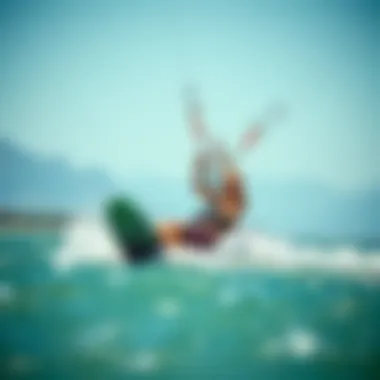
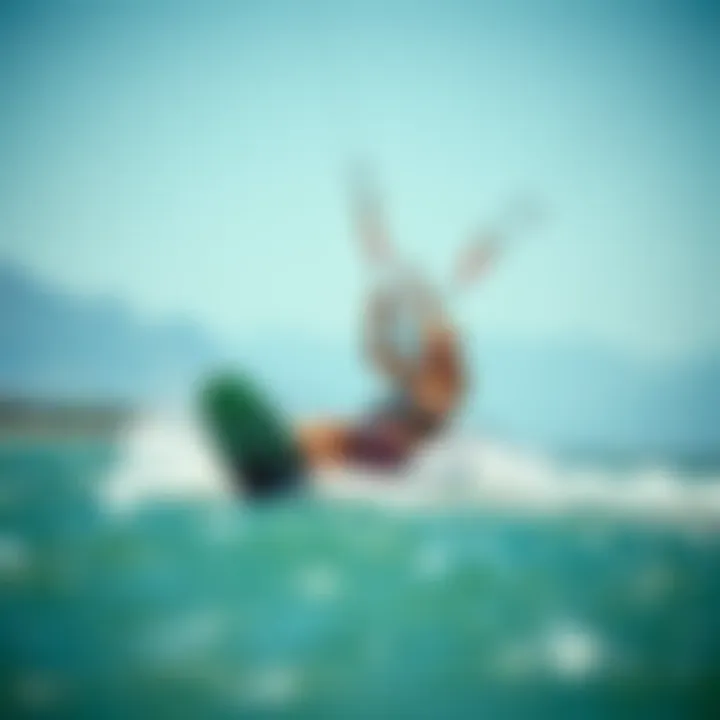
- Weather Systems: Be aware of changing weather systems. Taking note of storm fronts or sudden weather changes can impact your ride and slingshot execution. Ensure to check forecasts before heading out.
- Temperature: Cooler water temperatures can lead to discomfort, while also affecting your reflexes and reaction times. Dress appropriately for the conditions to maintain focus and comfort.
- Wildlife: In certain regions, seabed stones, marine life, or even unpredictable wave action can play a role in your performance. Being cautious of your surroundings helps prevent accidents while maintaining focus on your slingshot skills.
By grasping how these conditions interplay, kiteboarders can set themselves up for success. Being adaptable and aware of your environment will ultimately enhance your ability to execute the slingshot with confidence, allowing for smoother rides and thrilling maneuvers.
Safety Protocols in Slingshot Maneuvers
When kiteboarding, safety is paramount, especially when executing advanced maneuvers like the slingshot. These techniques can elevate performance to new heights, but they also come with risks that cannot be overlooked. Understanding and implementing safety protocols in slingshot maneuvers not only protects the rider but enhances the overall experience, allowing kiteboarders to push their limits with confidence.
Understanding Risks
Every sport has its dangers, and kiteboarding is no exception. The slingshot technique involves rapid acceleration and significant forces acting on both the kite and rider. A key risk lies in miscalculating the pull of the kite, which can cause loss of control. Additionally, varying wind conditions can make executing these maneuvers unpredictable.
Some potential risks include:
- Injury from falls: The high speeds involved can lead to serious injuries if a rider loses balance or control.
- Kite entanglements: Proper spacing from other kites is crucial; entangled lines can create dangerous situations for everyone involved.
- Environmental hazards: Sharp objects underwater or unpredictable water conditions can lead to accidents.
Awareness of these risks is the first step toward prevention. Riders should maintain a healthy level of respect for the elements, the equipment, and their own capabilities.
Pre-flight Checklist
Before hitting the water, a pre-flight checklist is key for ensuring that all equipment is in proper working order and that safety measures are in place. Each rider should develop a personal checklist, but here are some essential items to consider:
- Equipment inspection: Check kite, board, lines, and harness for any wear or damage. Look for frayed lines or punctures in the kite.
- Wind condition assessment: Evaluate wind speed and direction to ensure they are suitable for slingshot execution. Ideally, opt for steady winds.
- Safety gear: Ensure you have a well-fitted helmet and impact vest, which can offer crucial protection in case of a fall.
- Location check: Familiarize yourself with the water's surface, potential obstacles, and the presence of other riders.
- Buddy system: Always inform someone of your intentions and whereabouts. This practice ensures that help can reach you if things go awry.
By diligently following this checklist, riders set themselves up for a safer and more enjoyable experience.
Emergency Procedures
Even with thorough preparation, unforeseen events can still happen. Establishing a clear set of emergency procedures can significantly reduce the risks associated with kiteboarding and enhance passenger safety. Here are some crucial steps to consider:
- Know how to self-rescue: In case of malfunction or loss of control, understanding the procedure for self-rescue can prove invaluable. Practice this regularly to build muscle memory.
- Create a signal system: An agreed-upon signal with fellow kiteboarders can be critical for communication during emergencies. A simple hand signal can indicate distress or the need for assistance.
- Emergency contacts: Keep a list of emergency contacts easily accessible. Ensure friends or family know your kiteboarding schedule and can reach emergency services if necessary.
- Kite retrieval: If your kite ends up downwind or in a difficult spot, know how to get it back safely, ideally without putting yourself in danger.
Following these procedures helps manage emergencies effectively, providing a clear pathway for addressing unexpected situations and can even form the difference between a scary incident and a simple inconvenience.
Safety doesn’t take a backseat on the water; it’s the forefront of every successful kiteboarding session. Equip yourself with knowledge and precautions, and let nothing hinder your ride.
Expert Tips for Improving Your Slingshot Skills
Improving your slingshot skills in kiteboarding can make a real difference in how well you master the board and enhance your performance on the water. This section dives deep into expert tips that can help you elevate your technique, ensuring that you not only perform the slingshot maneuver but do so efficiently and effectively.
Learn from Professionals
One of the simplest yet most effective ways to improve is by learning from seasoned kiteboarding professionals. These individuals have spent countless hours honing their techniques and can offer insights that books and videos simply can’t replicate. Whether it’s an informal beach chat or a structured lesson, absorbing knowledge from experts can fast-track your improvement.
For example, many professional kiteboarders share their techniques through tutorial videos on platforms like YouTube or personal blogs. Following their channels may provide you with exclusive tips and tricks, tailored advice, and innovative approaches that you can integrate into your own practice.
Suggested Resources
Video Analysis of Your Technique
Recording yourself while executing the slingshot technique can be an eye-opener. Sometimes you might feel you are doing everything right, yet a video may reveal inconsistencies in your form or timing. When watching your footage, look for key aspects like your body positioning during the pull-off, how you manage the kite, and your control over the board.
Analyzing these clips allows for an objective view of your performance. Furthermore, you can compare your videos with tutorials or professional clips to pinpoint areas for improvement. Consider using apps designed for video analysis, which can slow down clips, allowing you to observe movements frame-by-frame.
Feedback from the Kiteboarding Community
Engaging with the community can be another game-changer for improving your slingshot skills. Online forums, local clubs, or social media groups are excellent platforms for connecting with other kiteboarders. By sharing your experiences and receiving feedback, you create a cycle of learning that benefits everyone involved.
Here are a few ways to tap into this resource:
- Participate in Local Meetups: Many kiteboarding enthusiasts gather regularly to share experiences and conduct informal training sessions.
- Join Online Communities: Platforms like Facebook and specialized forums on sites such as kiteforum.com offer spaces to ask questions, share videos, and receive constructive critiques.
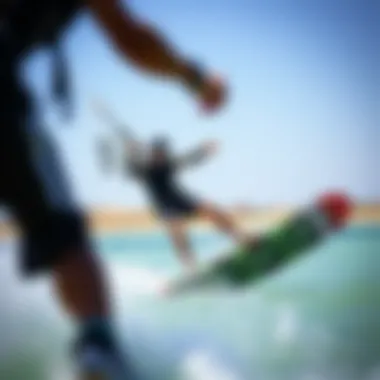
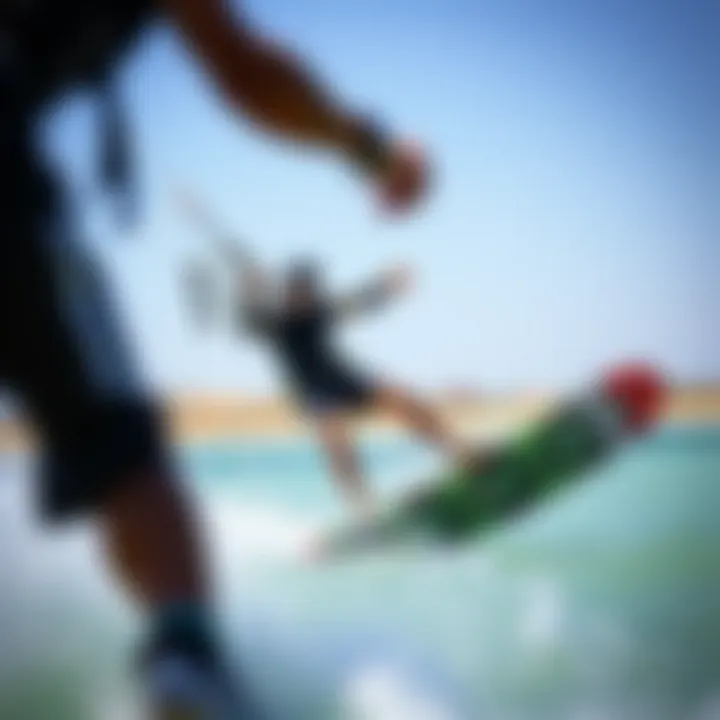
"The learning never stops; there's always a new trick or technique waiting just around the corner."
Summary
Improving your kiteboarding skills, especially regarding the slingshot technique, is a multifaceted journey. Learning from professionals, leveraging video analysis, and engaging with the kiteboarding community are essential aspects of mastering this skill. Continuous learning and feedback loops will pave the way for excellence, enabling you to hit the water with confidence and flair.
The Evolution of Kiteboarding Techniques
Kiteboarding has morphed into an engaging sport over the decades, blending art, science, and a fair bit of innovation. The evolution of techniques, especially the professional slingshot, has played a pivotal role in enhancing performance. Recognizing how these techniques have developed provides vital insights for aspiring kiteboarders. It's not just about riding the waves anymore; it’s about leveraging state-of-the-art equipment and age-old wisdom.
Historical Context of the Slingshot
The slingshot maneuver traces its roots back to the early days of kiteboarding. Initially, kiteboards relied heavily on basic concepts of balancing and harnessing wind power. As enthusiasts experimented, they noticed that pulling back on the kite for a brief moment allowed for impressive bursts of speed and height. This was the birth of the slingshot technique.
In the late 1990s and early 2000s, riding styles began to diversify. The slingshot technique was not just a trick; it became a fundamental way to navigate across the water more effectively. Surfers quickly adapted it from wakeboarding and surf, refining their movements in the process. The essence of the slingshot: timing, position, and speed all came together, marking a turning point in kiteboarding.
As riders grew more skilled, it became clear that mastering the slingshot was more than just for show; it’s crucial for competitive success. With slingshot techniques regularly turning up in competitions like the King of the Air, enthusiasts recognized that without a solid grasp of this skill, they would be left in the dust.
Technological Advancements
Technology has tugged at the strings of kiteboarding, propelling the sport into exhilarating new territories. In recent years, advancements in kite design and construction have transformed how riders approach the slingshot. The evolution of materials, such as lighter fabrics and more flexible frames, has improved kites' responsiveness. This means that when a rider pulls back, the kite reacts quicker and with more power.
Some notable advancements include:
- Inflatable Kites: These have become a staple, offering stability and ease of transport.
- Smart Control Systems: Sensors located in kites can adjust tension, making the kite more aerodynamic and allowing for better performance.
- Board Designs: Companies are now producing boards specifically tailored for slingshot maneuvers. These boards provide better grip and control on water, which is essential for achieving lift.
Ultimately, the integration of technology into kiteboarding practices not only enhances individual performance but also sets the stage for future innovations. Riders today find themselves at the intersection of tradition and cutting-edge technology, paving the way for new techniques and maneuvers. As the sport evolves, one thing is clear: the slingshot technique will continue to be a cornerstone of kiteboarding, driven by both rich history and dynamic innovation.
Building a Community Around Kiteboarding
In the world of kiteboarding, passion is often matched only by the strengthening bonds we create within our communities. Building a community around kiteboarding offers a multitude of benefits for enthusiasts of all levels. Not only does it provide a platform for sharing knowledge and skills, but it also cultivates friendship and support among kiteboarders. This camaraderie can lead to safer practices on the water and an overall enhancement in your kiteboarding experience.
By connecting with others, you’ll find encouragement, shared stories, and access to invaluable resources that can help improve your slingshot technique and performance. Moreover, community-driven insight can reveal local winds, tides, and spots that are best suited for your needs. Building connections with others enriches your journey and builds a foundation for lifelong friendships.
"A kiteboarding community isn't just about the thrill of riding; it's about the bonds we forge and the stories we share."
Connecting with Other Enthusiasts
Connecting with fellow kiteboarders is essential for anyone looking to elevate their skills. Whether through local gatherings or online forums, engaging with other enthusiasts can foster growth in ways you never considered. Many kiteboarding aficionados share tips and techniques that can be a game changer for both novice and seasoned riders alike.
Consider utilizing platforms like Reddit or dedicated Facebook groups that focus on kiteboarding camaraderie. Engaging in these communities allows you to share your own experiences and ask questions that can enhance your understanding of the sport.
Additionally, when you connect with others, you might discover opportunities for shared travels to exotic kiteboarding locations. Group trips can offer not only enhanced experiences but also shared costs, making it easier for more enthusiasts to hit the water, expand their skills, and deepen friendships.
Participating in Events and Competitions
Diving into events and competitions is another key aspect of building a kiteboarding community. These gatherings draw together riders from all walks of life, creating a vibrant tapestry of cultures and experiences. Whether you're competing or spectating, the energy at competitions can be electric.
Entry into competitions is about more than just winning trophies; it’s about personal growth and camaraderie. Events such as the King of the Air or local kiteboarding festivals bring together enthusiasts and professionals alike. They serve as a platform for showcasing talents and learning from others. Detailed tutorials and live demonstrations can often be found, offering invaluable insights into the skills required for advanced maneuvers like the slingshot.
Participating in these events allows you to network with key industry figures, gain exposure to new equipment, and explore trends in kiteboarding. More importantly, you’ll foster connections that may lead to lasting friendships that extend far beyond the water.
In essence, building a community around kiteboarding is a significant endeavor that can yield rewarding benefits. By connecting with other enthusiasts and actively participating in events, you not only sharpen your own skills but also contribute to the vibrant culture of kiteboarding itself. As you immerse yourself in this community, the thrill of the sport becomes a shared adventure that can enhance your enjoyment and performance in ways you’ve never expected.
The Future of Slingshot Techniques
The realm of kiteboarding is remarkably dynamic, constantly evolving to harness both innovative technology and the desires of its passionate community. As kiteboarding enthusiasts push the boundaries of what’s possible, the future of slingshot techniques emerges as a pivotal topic worth dissecting. Understanding upcoming trends and future predictions is crucial for both seasoned riders and those itching to dive into the sport. Various elements, including advancements in kite technology, changes in training methodologies, and shifts in environmental consciousness, will shape how slingshot techniques develop.
Emerging Trends in Kiteboarding
In recent times, several emerging trends are beginning to reshape the landscape of kiteboarding, impacting slingshot performance specifically.
- Sustainable Practices: A focus on sustainable materials has taken center stage. Many manufacturers are experimenting with eco-friendly fabrics and recycling methodologies for kite production. This not only reduces the ecological footprint but also enhances performance.
- Smart Technology Integration: Gadgets like smart kites, which utilize sensors to analyze flight patterns, are on the rise. This technology can provide real-time feedback, allowing riders to refine their slingshot techniques based on empirical data.
- Increased Popularity of Freestyle and Big Air: The popularity surge in freestyle and big air disciplines has influenced training practices. Slingshot techniques tailored for aerial maneuvers are being highlighted, incorporating spins and grabs which require precise control and timing.
- Online Learning Platforms: With the digital age in full swing, there are more online courses and communities than ever before. Riders can share their slingshot techniques and receive mentorship through video tutorials, fostering a culture of knowledge sharing among kiteboarders.
"The future of kiteboarding lies not just in advancing our techniques but also in our responsibility towards the environment and each other."
Predictions for Advanced Techniques
Looking ahead, the kiteboarding community can expect to see a variety of advanced slingshot techniques that will redefine how we interact with the sport. Some predictions include:
- Personalized Gear Technologies: Tailored equipment that adapts to individual riding styles may soon be commonplace. Imagine a kite that automatically adjusts its tension and shape based on your weight redistributions during slingshot maneuvers.
- Augmented Reality Training: Picture an augmented reality headset that provides you visual cues while you ride. Such technology could elevate the learning process, allowing kiteboarders to visualize their movements in real-time.
- Enhanced Safety Measures: As kiteboarders challenge themselves more than before, safety gear will evolve in tandem. New harness designs could integrate smart systems that monitor stress and strain, alerting riders when conditions become dangerous.
- Community-centric Competitions: Competitions may shift towards a more community-oriented approach, possibly with voting systems integrated through online platforms that allow fans to engage with and support their favorite riders.















